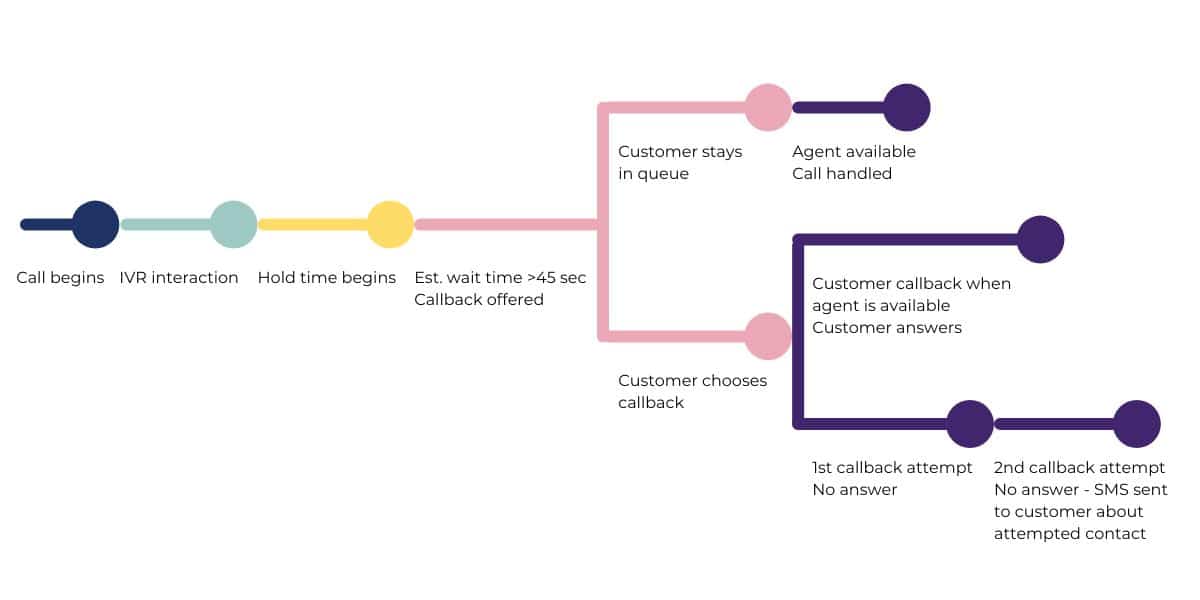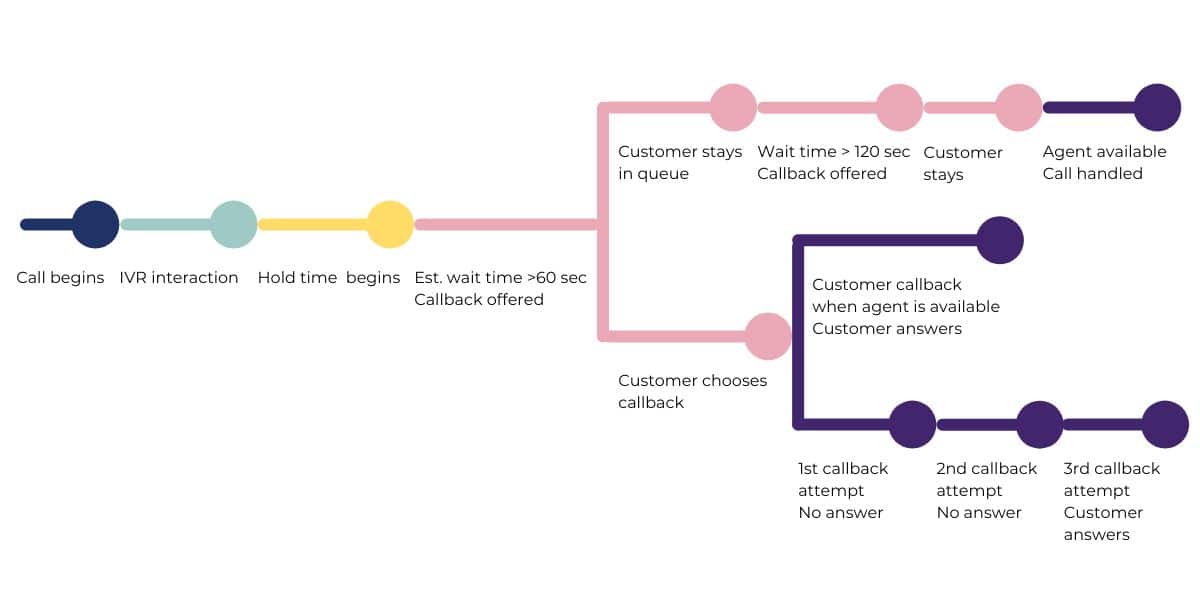

Why should you use a callback solution?
Are you considering implementing a callback solution? Here are a few compelling reasons why you should consider this type of call center software function.
4 benefits of a callback function
Customer Satisfaction
Not having to wait in a queue is a main driver for customer satisfaction. In fact, Hubspot Research shows that 2/3 of customers are most frustrated by waiting on hold. Reducing the effort to get in contact with you will improve you Customer Effort Score.
Reduce abandoned calls
Callbacks can be offered in situations where you risk abandoned calls due to long hold times. High abandonment and repeat calls can put a strain on any customer service department. Improving abandon rate is one of the main reasons companies add this type of call center software.
Service Level improvements
Even if only a few customers choose this function, this improves the service level for the customers that choose to wait and stay on the line. Customers who are less frustrated is not only good for your service levels but also helps boost employee morale.
Reduce expenses
You are paying for every minute that your customer is waiting in your phone queue. By moving calls from the time all agents are busy to a period that is less busy, the occupancy rate is improved and staff is better utilized. Cost per transaction is reduced. If reducing cost is your highest priority you can also implement a customer-first-callback. That will save the agent’s time for dialing the call as the customer is dialed first from the IVR.
Two examples of using a callback service
Case 1, Consumer Bank with high value clients
Identified needs, customers are expecting very high service. The bank has service level objective 80% answered calls within 60 seconds. The Bank experience problems reaching service level goals on Monday and Tuesday morning.
The Bank implements Callback specifically for Mon-Tue between 08.00 and 14.00. Callers with Estimated Wait Time above 45 seconds get offered to opt-in to callback in the Welcome message.
35% of customers accept the offer and these calls are handled by a team of backoffice agents. These are agents primarily working with administration and email. They help save the service level two days a week by staffing the callback queue.
Calls are distributed to the agents using Progressive dialing where agents get a notification and accept to handle the call. On acceptance the system automatically dials the outbound call to the customer. If the customer cannot be reached, a second attempt to call is scheduled automatically for 10 mins later. The customer will at the same time get an SMS explaining that The Bank has tried to reach them and that a second attempt will be done in approximately 10 minutes. Should the second attempt also fail the customer gets a second SMS with a notification including The Banks number (click to call on any smartphone) and a message explaining this was the second and final attempt, we hope you call The Bank at your own convenient time.
 Results from this implementation was higher customer satisfaction and higher service level on these critical days resulting in reaching the service level goal with less staff in first line. It also meant better co-operation between the back office team and front office team with a joint success story.
Results from this implementation was higher customer satisfaction and higher service level on these critical days resulting in reaching the service level goal with less staff in first line. It also meant better co-operation between the back office team and front office team with a joint success story.
The call center manager closely followed the callback opt-in rates, the Service Level achievements, Successful callbacks, Customer Satisfaction on callback-calls vs inbound calls and was able to make adjustment to thresholds from time to time to optimize utilization of the first-line team and balancing service level and costs.
Adding this call center software function as part of the disaster recovery plan was also done by adding callback for all weekdays with a second much higher threshold (15 minutes queue) and also if no agents are available. These callbacks had a separate callback-queue designed for first line agents. This is helpful if e.g. the service center has a fire drill, power outages or other disasters.
Case 2, Telecom operator with high volume of calls with relative low value
Identify needs, customers are often waiting 5 minutes or more. The Telco are on a strict budget and need to maximize the agents time with customer interactions. Customers are willing to wait but hate staying on the line, sometimes for an hour or more to speak with Telco support-line.
The Telco implemented a call center software service that offers callers to opt-in for a callback after 60 seconds in queue and a new offer is presented every 120 seconds in queue. This is turned on 24/7 as the callcenter is always open.
60% of callers accept the callback function sooner or later in the queue. Callers are asked a couple of questions regarding the problem and the urgency of the call. Callback is scheduled based on the customer input. Many callers are willing to wait until next day for the callback given they get to speak with an expert of their specific problem.

Back-back requests are distributed to several queues based on the customer profile and the specific service the customer experience problem with. This allows the Telco to use skills-based routing and assign callbacks to the best suitable and available agent. Calls are also used to move calls from understaffed periods to periods where the service centers are better staffed. This resulted in more evenly work balance and distributing calls to correct skilled agents reduce the average handle time on callback calls compared to inbound managed calls.
Using the Customer-first-callback option where the system first connects the call to the customer and then let the customer wait until it’s connected to the agent result in no extra agent time is spent on listening to ring-back or waiting for calls where the customer was unable to answer. This is from a productivity perspective very efficient.
Callers that don’t pick up on the first callback attempt will get 2 more attempts 20 and 60 minutes after the first. After the 3:rd attempt a SMS will ask the caller to callback them self as they have not been reachable.
Callback services with Connectel
As described in this text, there are many use cases and options on how to implement callback. Most organizations have their specific needs and Connectel can help tailor the call center software function to your needs. We use standard functionality in our platform and use the flexible configuration available to implement any of the callback options described in this text. The configuration requires to set up different queues, priorities, thresholds, IVR-blocks, routing, SMS-services and such. Therefore, implementing advanced callback to your needs and wishes are a consultant service we love to help you with. Depending on level of sophistication can require new licenses and services.
We hope this text inspires you to try callback and to start improving your customer- and agent satisfaction.


